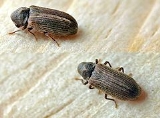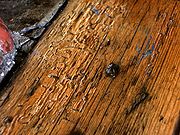
Common furniture beetle
Encyclopedia
The common furniture beetle or common house borer (Anobium punctatum) is a woodboring beetle
. In the larva
l stage it bores in wood and feeds upon it. Adult Anobium punctatum measure 2.7–4.5 mm
in length. They have brown ellipsodial bodies with a pronotum resembling a monk's cowl
.
 The first step in pest control is prevention, and for this it is helpful to understand that Anobium punctatum only attacks seasoned sapwood
The first step in pest control is prevention, and for this it is helpful to understand that Anobium punctatum only attacks seasoned sapwood
timber, not live or fresh wood. Also, it usually does not attack heartwood timbers. This is readily observed from infested structures, where one piece of timber may be heavily attacked but an adjacent one left virtually untouched according to whether it is made from the heartwood or the sapwood part of a tree trunk. Infestations are also usually a problem of old wooden houses built with untreated timbers. Some building regulations state that timbers with more than 25% sapwood may not be used, so that wood borer infections can not substantially weaken structures.
Infection, past or present, is diagnosed by small round exit holes of 1 to 1.5 mm diameter. Active infections feature the appearance of new exit holes and fine wood dust around the holes.
Because of the 3–4 year life cycle of Anobium punctatum, timber or timber products bought containing an A. punctatum infection may not manifest holes until years after the timber has been acquired. Infestation can be controlled by application of a residual insecticide (such as permethrin
) to infected areas, by professional fumigation, or by replacing infected timber . Simple aerosol insecticide sprays will only kill the adult borer on the wing but not the burrowing larvae, which remain relatively protected inside infected timbers.
Woodboring beetle
The term woodboring beetle encompasses many species and families of beetles whose larval or adult forms eat and destroy wood . Larval stages of some are commonly known as woodworms.-Invasion and control:...
. In the larva
Larva
A larva is a distinct juvenile form many animals undergo before metamorphosis into adults. Animals with indirect development such as insects, amphibians, or cnidarians typically have a larval phase of their life cycle...
l stage it bores in wood and feeds upon it. Adult Anobium punctatum measure 2.7–4.5 mm
Millimetre
The millimetre is a unit of length in the metric system, equal to one thousandth of a metre, which is the SI base unit of length....
in length. They have brown ellipsodial bodies with a pronotum resembling a monk's cowl
Cowl
This article is about the garment used by monks and nuns. For other uses, see Cowl or Cowling .The cowl is an item of clothing consisting of a long, hooded garment with wide sleeves. Originally it may have referred simply to the hooded portion of a cloak...
.
Life cycle
Adults do not feed; they just reproduce. The female lays her eggs into cracks in wood or inside old exit holes, if available. The eggs hatch after some three weeks, each producing a 1 mm long, creamy white, C-shaped larva. For three to four years the larvae bore semi-randomly through timber, following and eating the starchy part of the wood grain, and grow up to 7 mm. They come nearer to the wood surface when ready to pupate. They excavate small spaces just under the wood surface and take up to eight weeks to pupate. The adults then break through the surface, making a 1mm to 1.5 mm exit hole and spilling dust, the first visible signs of an infestation.Pest control

Sapwood
Sapwood may refer to:* Sapwood, the part of living wood where sap flows, as distinct from the heartwood, where it doesn't* SS-6 Sapwood, the NATO reporting name for the R-7 Semyorka intercontinental ballistic missile...
timber, not live or fresh wood. Also, it usually does not attack heartwood timbers. This is readily observed from infested structures, where one piece of timber may be heavily attacked but an adjacent one left virtually untouched according to whether it is made from the heartwood or the sapwood part of a tree trunk. Infestations are also usually a problem of old wooden houses built with untreated timbers. Some building regulations state that timbers with more than 25% sapwood may not be used, so that wood borer infections can not substantially weaken structures.
Infection, past or present, is diagnosed by small round exit holes of 1 to 1.5 mm diameter. Active infections feature the appearance of new exit holes and fine wood dust around the holes.
Because of the 3–4 year life cycle of Anobium punctatum, timber or timber products bought containing an A. punctatum infection may not manifest holes until years after the timber has been acquired. Infestation can be controlled by application of a residual insecticide (such as permethrin
Permethrin
Permethrin is a common synthetic chemical, widely used as an insecticide, acaricide, and insect repellent. It belongs to the family of synthetic chemicals called pyrethroids and functions as a neurotoxin, affecting neuron membranes by prolonging sodium channel activation. It is not known to...
) to infected areas, by professional fumigation, or by replacing infected timber . Simple aerosol insecticide sprays will only kill the adult borer on the wing but not the burrowing larvae, which remain relatively protected inside infected timbers.

